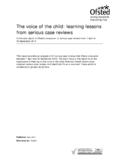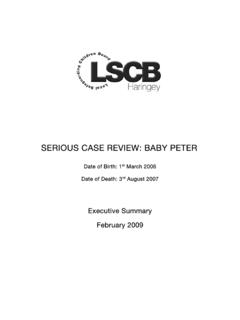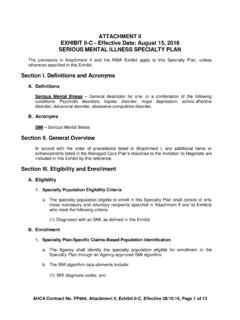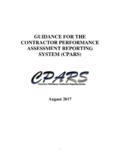Transcription of Offshsore Info sheet 4/2009 Guidance on management of ...
1 HSE Information sheet Guidance on management of ageing and thorough reviews of ageing installations Offshore Information sheet No. 4/2009 ContentsIntroductionBackgroundThorough review summaryIssues with ageingManagement of ageingReferencesFurther informationIntroductionThis information sheet provides Guidance for asset managers, safety managers and safety engineers in the offshore industry on taking account of ageing of the installation during thorough review , which is required by the Offshore Installations (Safety Case) Regulations 2005 (SCR05) requires the dutyholder to carry out a 5-yearly thorough review of the safety case2. The purpose of the thorough review is to confirm that: xthe safety case as a whole continues to be fundamentally sound;xthe relevant statutory provisions3 are being complied with taking account of all relevant changes and new knowledge since the case was last accepted; and xthe safety case continues to demonstrate the effective identification, management and control of major accident hazard risks on the effect this means that the review must ensure that the case demonstrates that the installation can continue to be safely operated and that the structure, together with its associated plant, can continue to meet the necessary performance standards to enable compliance with the relevant statutory provisions.
2 This involves consideration not only of new knowledge and current good practice, but of the changes which may have occurred as a result of the ageing of the installation. This document provides Guidance on incorporating ageing issues into thorough reviews. It discusses the thorough review process and how this is related to the effective control of hazards on ageing installations, covering fire and explosion, structural integrity, organisational and other ageing safety management system (SMS) of the installation needs to address ageing and the thorough review is one tool to assist the process (see Figure 1). It may also be appropriate to address ageing issues when there is a revised safety case to address a material change. Policy for addressing ageingOrganisation includingcompetencyProcedures etc for: o Inspectiono MaintenanceoManagement of changeo Operational riskassessmentoSafety case and ALARP reviewsMonitoring inspection,KPIs, incident investigationAudit (inclusion of ageing)Identifiedadditional possiblerisk reductionmeasuresFitness for purposeperformancestandardsOperational safety caseThorough reviewand summaryRevision of safety case, relating to life extension demonstration, (as required)ALARP and compliancedemonstrationFire & explosion riskassessmentSafety case StructuralintegrityassessmentSMSR eview and feedback of strategic issuesFigure 1.
3 Relationships between SMS and safety case in terms of management of ageing This document is intended to help operators and technical authorities to review the impact of ageing of an offshore installation on the risk from majoraccidents involving the structure, wells, process, export and interfacility fluids (pipelines) for inclusion in the demonstration required in the safety case. It willform a frame of reference that can be used by all interested parties to ensure the best available knowledge is used in that demonstration. It particularly addresses ageing issues relevant to 5-yearly thorough review of the safety document is aimed at engineers of all disciplines and safety practitioners. It is supported by more detailed reports, which focus in particular on fire and explosion issues4 and the structural integrity issues5, and which make reference to specific standards and review of the safety case The objectives of the thorough review are: 1 to confirm that the safety case, with any necessary updates, is still adequate, and is likely to remain so until the next thorough review ; 2 compare the case against current standards, HSE Guidance (such as APOSC6, GASCET7, offshore safety case guidance3) and industry practice for new installations; to evaluate any deficiencies; and to identify and implement any reasonably practicable improvements to enhance safety; 3 identify design parameters, ageing processes, changes in operating conditions and hence performance standards that may limit the life of the installation, or of its safety critical elements.
4 And 4 check that the management of safety is adequate, in particular that performance standards and key performance indicators (KPIs) are relevant and effective. The thorough review is therefore expected to not only confirm that issues concerning ageing have been identified, but also that they are being adequately managed, and that reasonably practicable improvements are identified and implemented. This should include addressing the information in this Guidance and the more detailed reports4, examples of the arrangements expected to be considered in the thorough review include, but are not limited to: xdesign and operational parameters of the structure and plant, together with actual operational experience and projected operational status and lifetime, fatigue and corrosion life of the topsides and structure, use of measured corrosion rates and measured structural loading parameters, changes to metocean parameters and accidental loading criteria;xtaking account of the findings of the Key Programmes, including Key Programme 3 Asset Integrity Programme8;xprevention of degradation becoming so serious that improvements become impossible; xmaintenance, inspection and testing experience of safety critical elements (SCEs) and consideration of whether test intervals are adequate given the testing history etc.
5 ; xmodifications to the installation or plant including SCEs to ensure that the installation hazard profile remains tolerable and as low as reasonably practicable (ALARP); xchanges to, and to the current role and behaviour of, SCEs and their associated performance standards; xhow structural degradation affects the performance of SCEs; xthe history of incidents and abnormal / unexpected events, the updating of task and operational risk assessments to include known hazards from past incidents; xnew knowledge and understanding, awareness of risks highlighted by industry or HSE safety alerts (for example on temporary repairs9);recognition and inclusion of findings from relevant research; xchanges in safety standards or safety methodology / assumptions, the publication of new codes and standards; xchanges in management of safety and human factors aspects affecting the installation, arrangements for ensuring competence and adequate staffing levels. Systems and procedures should be in place to identify and rectify issues arising from ageing (see section below on management of ageing) by means of, for example: xInspectionxPlanned maintenancexChange control procedure (modifications) xOperational risk assessment ( in the event of failures) xIncident investigationIn addition to this the duty holder is encouraged to conduct regular reviews of ageing issues so that strategic solutions can be developed.
6 The 5 yearly thorough review of the safety case will provide one such opportunity. The dutyholder needs to be aware of the current condition and remaining life of the structure and equipment, particularly SCEs, in relation to the anticipated installation life. This is particularly important for older installations receiving new hydrocarbon streams. Strategic decisions need to be made in sufficient time about maintenance, repair and replacement against a background of well and process changes and improvements in technology and good practice. Ageing is not about how old your equipment is; it s about what youknow about its condition, and how that s changing over time 10 Asset life extensionMany of the offshore platforms in the UK sector are nearing the end of their originally intended design life. However, with the depletion of hydrocarbon reserves, the increased use of enhanced oil recovery technologies, and the advent of carbon dioxide sequestration, there is an increasing requirement to extend the life of the existing platforms.
7 Other installations, although no longerproducing oil from their own wells are being modified to act as production hubs, taking hydrocarbons from other sub sea wells in the area and processing it there, often with new or modified topsides plant, for export to pipeline or life extension raises several issues in relation to hazard management , for example: xthe need for specific demonstration of fitness for purpose beyond the original design life of the structure and of equipment; xdesign and operational issues relating to integration of new plant, processes or materials with old; xeffect of new fire and explosion scenarios from new plant etc. on existing mitigation systems, HVAC, fire and gas detection, active and passive fire protection systems; xrepair and use of passive fire protection and provision of integrity insurance for ageing piping/structure/equipment;xdegradation of emergency equipment and facilities;xequipment obsolescence leading to substitution, modification or plant outage;xthe effects of changes resulting from ageing on the installation s risk assessment, particularly that related to fire and explosion hazards; xincreases and decreases in operational loads and their effect on structural safety and foundation failure; xunderstanding of degradation processes; xthe need for detailed knowledge of the current state of the structure; xthe need for better understanding of the structural response in the effective management of ageing requires the understanding of a number of factors, and the application of a range of techniques to assess and manage the ageing situation.
8 These are illustrated schematically in Figure is best to plan in advance for any future life extension of the installation. Any reduction in maintenance regime in anticipation of end of life requires careful consideration as it will make any subsequent life extension more difficult and costly. Any change from a programme of scheduled maintenance to a regimeof on-condition maintenance will require the necessary design changes to enable the required level of condition monitoring. This includes adequate plantaccess for monitoring and robust models of wear rates etc Systems and procedures should also be in place to:xCarry out an extended life assessment when required and include this in the current revision of the safety case; Consider the need for a revised fire and exxplosion assessment to becarried out and included in the current safety case. Managementof ageing platformsAgeing/deteriorationChange of hazard profile of platform ModificationsThorough review of safety caseAppropriatechanges to keyrisk controlsystems and SCEs Extended life assessment (if appropriate)Revised fire and explosionassessment (if appropriate)Appropriateinspection strategyand programme Improvementsin knowledgeand/or good practiceFigure 2: Overview of management of ageing considerations Thorough review summaryIt should be clear that the thorough review has included consideration of ageing and the summary submitted to HSE should include brief details of: xthe ageing issues, which have been considered in the review ; xany extended life assessment or revision to the fire and explosion risk assessment;xany changes to the management arrangements to take into account ageing.
9 And xthe conclusions as to the impact on the case for with ageingThis section gives information about technical issues which need to be considered when managing ageing. Further details are given in the detailed reports for fire and explosion4and structural integrity5. The following issues are pertinent to the consideration and management of ageing: includes the effects of wear and tear, external and internal corrosion, structural fatigue, obsolescence of equipment, and reduction of equipment reliability. Table 1 shows some indicators of ageing which were identified in HSE Research Report RR50910, together with examples relevant to offshore installations4. Inthe UK sector of the North Sea, gas production started in 1968 and oil in 1974. Most of the facilities are still in place and in use, many beyond their original design life, and hence deterioration is very relevant to many installations. Table 1: Some aspects of ageing and deterioration of offshore installationsIndicator of Ageing Examples relevant to offshore installations External indicators of corrosion or deteriorationPaint blistering, rust streaks, evidence of corrosion at screwedjoist or bolts, softening of passive fire protection (PFP).
10 Surface corrosion of blast walls may indicate that their structuralresponse has been adversely affected. External indications of incomplete reinstatement. Loose covers, ill fitting enclosures, loose bolts, missing equipment, incomplete systems, F&G Variations in standardsModifications carried out to a higher standard such as doubleblock and bleed or non screwed fittings while the original plant has earlier, lower standardsLack of commonality/incompatibilityReplacement equipment of a later design or from an alternative supplier. Interface problems between modern and older controlsystemsDeterioration in plantperformanceDifficulty in achieving a seal in isolation and ESD valves; Deterioration in pump performance, lower flow rates in deluge systems due to blockage, loss of sensitivity of detectors. Bearings may heat up and form previously unrecognisedignition sources. Deterioration in structuralperformanceInitiation and propagation of fatigue cracks in of uninspectable SCEs, For example foundations, ring stiffened and single sided jointsIncreasing congestionand lack of optimal layout Location of new plant such as pig traps in non optimal locationsbecause of the lack of available space.

















